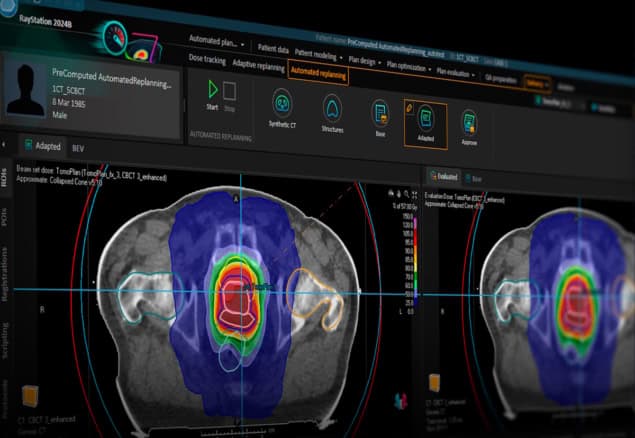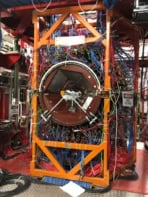RaySearch Laboratories is pioneering the development of rapid adaptive planning software to help clinics implement online adaptive radiotherapy

Radiation therapy is a targeted cancer treatment that’s typically delivered over several weeks, using a plan that’s optimized on a CT scan taken before treatment begins. But during this time, the geometry of the tumour and the surrounding anatomy can vary, with different patients responding in different ways to the delivered radiation. To optimize treatment quality, such changes must be taken into consideration. And this is where adaptive radiotherapy comes into play.
Adaptive radiotherapy uses patient images taken throughout the course of treatment to update the initial plan and compensate for any anatomical variations. By adjusting the daily plan to match the patient’s daily anatomy, adaptive treatments ensure more precise, personalized and efficient radiotherapy, improving tumour control while reducing toxicity to healthy tissues.
The implementation of adaptive radiotherapy is continuing to expand, as technology developments enable adaptive treatments in additional tumour sites. And as more cancer centres worldwide choose this approach, there’s a need for flexible, innovative software to streamline this increasing clinical uptake.
Designed to meet these needs, RayStation – the treatment planning system from oncology software specialist RaySearch Laboratories – makes adaptive radiotherapy faster and easier to implement in clinical practice. The versatile and holistic RayStation software provides all of the tools required to support adaptive planning, today and into the future.
“We need to be fast, we need to be predictable and we need to be user friendly,” says Anna Lundin, technical product manager at RaySearch Laboratories.
Meeting the need for speed
Typically, adaptive radiotherapy uses the cone-beam CT (CBCT) images acquired for daily patient positioning to perform plan adaptation. For seamless implementation into the clinical workflow to fully reflect the daily anatomical changes, this procedure should be performed “online” with the patient on the treatment table, as opposed to an “offline” approach where plan adaptation occurs after the patient has left the treatment session. Such online adaptation, however, requires the ability to analyse patient scans and perform adaptive re-planning as rapidly as possible.
To fulfil the needs for streamlining all types of adaptive (online or offline) requirements, RayStation incorporates a package of advanced algorithms that perform key tasks, including segmentation, deformable registration, CBCT image enhancement and recontouring, all while the previously delivered dose is taken into consideration. By automating all of these steps, RayStation accelerates the replanning process to the speed needed for online adaptation, with the ability to create an adaptive plan in less than a minute.

Central to this process is RayStation’s dose tracking, which uses the daily images to calculate the actual dose delivered to the patient in each fraction. This ability to evaluate treatment progress, both on a daily basis and considering the estimated total dose, enables informed decisions as to whether to replan or not. The software’s flexible workflow allows users to perform daily dose tracking, compare plans with daily anatomical information against the original plans and adapt when needed.
“You can document trigger points for when adaptation is needed,” Lundin explains. “So you can evaluate whether the original plan is still good to go or whether you want to update or adapt the treatment plan to changes that have occurred.”
User friendly
Another challenge when implementing online adaptation is that its time constraints necessitate access to intuitive tools that enable quick decision making. “One of the big challenges with adaptive radiotherapy has been that a lot of the decision making and processes have been done on an ad hoc basis,” says Lundin. “We need to utilize the same protocol-based planning for adaptive as we do for standard treatment planning.”
As such, RaySearch Laboratories has focused on developing software that’s easy to use, efficient and accessible to a large proportion of clinical personnel. RayStation enables clinics to define and validate clinical procedures for a specific patient category in advance, eliminating the need to repeat this each time.
“By doing this, we let the clinicians focus on what they do best – taking responsibility for the clinical decisions – while RayStation focuses on providing all the data that they need to make that possible,” Lundin adds.
Versatile design
Lundin emphasizes that this accelerated adaptive replanning solution is built upon RayStation’s pre-existing comprehensive framework. “It’s not a parallel solution, it’s a progression,” she explains. “That means that all the tools that we have for robust optimization and evaluation, tools to assess biological effects, support for multiple treatment modalities – all that is also available when performing adaptive assessments and adaptive planning.”
This flexibility allows RayStation to support both photon- and ion-based treatments, as well as multiple imaging modalities. “We have built a framework that can be configured for each site and each clinical indication,” says Lundin. “We believe in giving users the freedom to select which techniques and which strategies to employ.”
We let the clinicians focus on what they do best – taking responsibility for the clinical decisions – while RayStation focuses on providing all the data that they need to make that possible
In particular, adaptive radiotherapy is gaining interest among the proton therapy community. For such highly conformal treatments, it’s even more important to regularly assess the actual delivered dose and ensure that the plan is updated to deliver the correct dose each day. “We have the first clinics using RayStation to perform adaptive proton treatments in an online fashion,” Lundin says.
It’s likely that we will also soon see the emergence of biologically adapted radiotherapy, in which treatments are adapted not just to the patient’s anatomy, but to the tumour’s biological characteristics and biological response. Here again, RayStation’s flexible and holistic architecture can support the replanning needs of this advanced treatment approach.
Predictable performance
Lundin points out that the progression towards online adaptation has been valuable for radiotherapy as a whole. “A lot of the improvements required to handle the time-critical procedures of online adaptive are of large benefit to all adaptive assessments,” she explains. “Fast and predictable replanning is crucial to allow us to treat more patients with greater specificity using less clinical resources. I see it as strictly necessary for online adaptive, but good for all.”
Artificial intelligence (AI) is not only a key component in enhancing the speed and consistency of treatment planning (with tools such as deep learning segmentation and planning), but also enables the handling of massive data sets, which in turn allows users to improve the treatment “intents” that they prescribe.

Learning more about how the delivered dose correlates with clinical outcome provides important feedback on the performance and effectiveness of current adaptive processes. This will help optimize and personalize future treatments and, ultimately, make the adaptive treatments more predictable and effective as a whole.
Lundin explains that full automation is the only way to generate the large amount of data in the predictable and consistent manner required for such treatment advancements, noting that it is not possible to achieve this manually.
RayStation’s ability to preconfigure and automate all of the steps needed for daily dose assessment enables these larger-scale dose follow-up clinical studies. The treatment data can be combined with patient outcomes, with AI employed to gain insight into how to best design treatments or predict how a tumour will respond to therapy.
“I look forward to seeing more outcome-related studies of adaptive radiotherapy, so we can learn from each other and have more general recommendations, as has been done in the field of standard radiotherapy planning,” says Lundin. “We need to learn and we need to improve. I think that is what adaptive is all about – to adapt each person’s treatment, but also adapt the processes that we use.”
Future evolution
Looking to the future, adaptive radiotherapy is expected to evolve rapidly, bolstered by ongoing advances in imaging techniques and increasing data processing speeds. RayStation’s machine learning-based segmentation and plan optimization algorithms will continue to play a central role in supporting this evolution, with AI making treatment adaptations more precise, personalized and efficient, enhancing the overall effectiveness of cancer treatment.
“RaySearch, with the foundation that we have in optimization and advancing treatment planning and workflows, is very well equipped to take on the challenges of these future developments,” Lundin adds. “We are looking forward to the improvements to come and determined to meet the expectations with our holistic software.”
- Get to know RaySearch’s oncology information system, RayCare, and explore the role it plays in adaptive radiotherapy.




